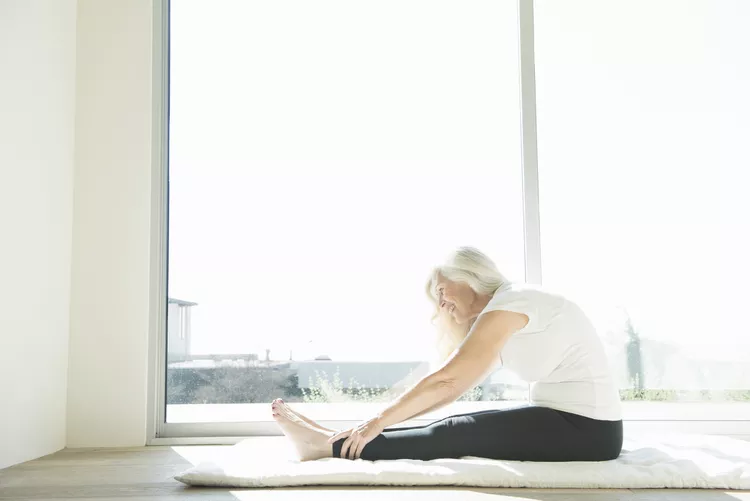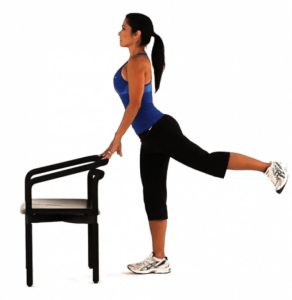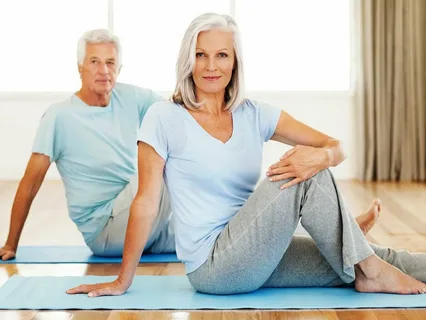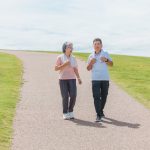Senior hip exercises stabilize the legs and spine by strengthening the hip joint and its supporting muscles. A weak or unstable hip joint puts your hip, knee, sacrum, and lumbar spine at risk for injury, pain, weakness, and decreased mobility.
By strengthening the hip joint, you can provide your legs with a more stable and balanced foundation to keep your upright as you move through your day. Senior hip strengthening exercises can even help relieve pain in the hips and knees.
This article provides six senior hip exercises to maintain hip health, reduce your risk of falls, and improve your mobility.

Hip Strengthening Exercises
The hip is a multidirectional joint that moves in three different planes. It allows the leg to move forward and backward, out to the side and across the body, and rotate internally and externally.
Your hips are controlled by the powerful, force-generating muscles of your legs—the glutes and quadriceps, the hamstrings, and the hip flexors. Senior hip exercises focus on strengthening these critical muscle groups, which work together to provide your body with a strong foundation for movement.
It is important for seniors to strengthen their hip muscles and joints in order to reduce the risk of falling. Furthermore, hip exercises can decrease pain and stiffness due to arthritis and other joint conditions, and maintain adequate strength and mobility for everyday activities.
These six senior hip exercises can help you do just that.
Seated Marching
This exercise strengthens the hip flexor muscles, which are responsible for lifting the leg up. This motion is especially important for advancing the legs while walking and going up stairs.
Weakness in the hip flexors can cause difficulty with walking by shortening the length of your steps and slowing down your walking speed. Increased difficulty lifting the legs can lead to foot drag, potentially resulting in trips and falls.
To perform this exercise:
- Sit in a sturdy chair with your knees bent and feet flat on the floor.
- Lift one leg up, bringing your knee closer to your chest.
- Hold for one second, then lower it.
- Repeat on the other leg.
- Alternate between both legs, performing 10 repetitions on each side.
- Rest, then repeat for a total of three sets of 10 repetitions for each leg.
Bridges

Adequate hip extension strength is needed for the leg to push off the ground to move forward when walking, stepping up when climbing stairs, and standing up from a seated position. The bridge exercise improves leg stability by strengthening the hips and glutes.
To perform this exercise:
- Lie on your back with your knees bent and feet flat.
- Squeeze your glute muscles to lift your hips up. Keep your back flat and do not arch your back.
- Hold for three seconds at the top, then lower your hips back down.
- Repeat for 10 repetitions.
- Rest, then repeat for a total of three sets of 10 repetitions.
Clamshells
This exercise helps strengthen the glute muscles, specifically the gluteus medius muscles on the sides of the hips, which support and stabilize the pelvis and improve standing balance.
To perform this exercise:
- Lie on your back with your knees bent and feet flat with a resistance band placed around your thighs above your knees.
- Keep your feet flat and push your knees out to the side against the band.
- Hold for three seconds, then bring your knees back together.
- Repeat for 10 repetitions.
- Rest, then repeat for a total of three sets of 10 repetitions.
If you want to take this exercise up a notch, follow these steps:
- Lie on your side with your knees bent and knees and ankles stacked with a resistance band placed around your thighs above your knees.
- Keep your ankles together and lift your knee up toward the ceiling. Do not allow your body or hips to roll backward.
- Hold for three seconds, then bring your knees back together.
- Repeat for 10 repetitions, then switch sides.
- Rest, then repeat for a total of three sets of 10 repetitions on each side.
Standing Hip Extension

Another senior hip exercise that strengthens the glute muscles is the standing hip extension exercise. This hip exercise also improves core strength to support your spine and take pressure off your hips.
To perform this exercise:
- Stand in front of a wall, table, counter, or chair to have support to hold on to.
- Keeping your leg straight, kick one leg back directly behind you. Do not bend your knee or let your back arch.
- Hold for one second, then return to the starting position.
- Repeat on the other leg.
- Alternate between both legs, performing 10 repetitions on each side.
- Rest, then repeat for a total of three sets of 10 repetitions for each leg.
Standing Hip Abduction

This exercise helps strengthen the gluteus medius muscles on the sides of the hips to improve hip abduction—the movement of the leg away from the midline of the body. Hip abduction allows you to step out to the side, get in and out of a car, and other sideways movements.
To perform this exercise:
- Stand in front of a wall, table, counter, or chair to have support to hold on to.
- Keeping your leg straight, kick one leg out to the side. Keep your body upright without leaning toward either side.
- Hold for one second, then return to the starting position.
- Repeat on the other leg.
- Alternate between both legs, performing 10 repetitions on each side.
- Rest, then repeat for a total of three sets of 10 repetitions for each leg.
Sit to Stand
The sit to stand exercise helps strengthen the glute muscles. It is similar to a standing squat, except that it utilizes a chair to protect your knees. This hip exercise improves your ability to squat safely, preventing falls while using the restroom, cleaning, or other movements that require you to bend at the knees and hips.
To perform this exercise:
- Sit in a chair with a firm surface (using a soft chair or couch will make it harder to stand up).
- Lean your body forward so that your nose is in line with your toes.
- Use your legs to push yourself up from the chair. Try not to use your hands to help you push up from the chair surface.
- Squeeze your glutes at the top to fully extend your hips once standing upright.
- Hold for one second, then push your hips back and slowly lower yourself back onto the chair without plopping down.
- Repeat for 10 repetitions.
- Rest, then repeat for a total of three sets of 10 repetitions.
To add a little bit more challenge to this exercise, try to:
- Stand in front of a chair.
- Push your hips back to slowly lower yourself down toward the chair. Make sure to lean backward and do not let your knees travel over your toes.
- Without sitting down all the way, lightly tap the chair with your buttocks, then return to standing.
- Repeat for 10 repetitions.
- Rest, then repeat for a total of three sets of 10 repetitions.
Video: “EXERCISES FOR THE ELDERLY | SENIOR’S ZONE”
EXERCISES FOR THE ELDERLY/SENIOR’S ZONE. FIRST DIRECTION: REHABILITATION AND SUPPORTIVE THERAPY FOR THE ELDERLY (THERAPEUTIC SET OF EXERCISES). INITIAL STAGE OF REHABILITATION
For additional information about exercises for the elderly | Senior’s zone you can watch a video demonstrating exercises and rehabilitation recommendations.
How to Exercise Safely

The senior hip exercises included in this article are meant to be performed safely and easily at home. If you find that any exercise creates pain or feels unsafe, skip it and try something else. You can always work your way up.
For example, if standing is difficult for you, start with exercises that are performed while seated or lying down. This way, you can spend some time building strength from a more comfortable position before moving on to standing exercises.
You might also find it helpful to perform standing exercises next to something stable, like a railing, table, or chair that you can utilize for support.
As you move through your hip exercises, focus on keeping your hips square and level. Avoid any unnecessary twisting or rotating in your hips, which can be harmful to your joints and make the exercise less effective.
When to See a Healthcare Provider

If you are experiencing significant hip pain, stiffness, or inflammation, you should see your healthcare provider to address your symptoms, determine a possible diagnosis, and refer you to physical therapy if necessary.
Don’t hesitate to call your doctor or go to the emergency room for any of the following symptoms:
- Inability to place weight on one or both of your legs
- Inability to move your leg or hip
- Hip pain due to an injury
- Signs of infection, such as a fever, redness, or chills
- A joint that appears deformed
- Any other new or unusual symptoms
Summary & source
Keeping your hips strong with exercises will allow you to perform everyday activities like standing, walking, going up and down stairs, and squatting or bending with ease. They can also decrease pain and stiffness and reduce the risk of falling.
If you are struggling to do these exercises or are not seeing any benefit, talk to your healthcare provider about getting a referral to physical therapy.
By Kristen Gasnick, PT, DPT
Kristen Gasnick, PT, DPT, is a medical writer and a physical therapist at Holy Name Medical Center in New Jersey.

CHECK OUT THE DEMO VERSION OF OUR WORKOUTS FOR THE REABILITAITON OF the elderly | Senior’s Zone ON YOUTUBE
Our website presents sets of exercises for the rehabilitation of the elderly | Senior’s Zone in the following areas:
-
EXERCISES FOR THE ELDERLY/SENIOR’S ZONE. FIRST DIRECTION: REHABILITATION AND SUPPORTIVE THERAPY FOR THE ELDERLY (THERAPEUTIC SET OF EXERCISES). INITIAL STAGE OF REHABILITATION
-
EXERCISES FOR THE ELDERLY/SENIOR’S ZONE. FIRST DIRECTION: REHABILITATION AND SUPPORTIVE THERAPY FOR THE ELDERLY (THERAPEUTIC SET OF EXERCISES). MIDDLE STAGE OF REHABILITATION
-
EXERCISES FOR THE ELDERLY/SENIOR’S ZONE. FIRST DIRECTION: REHABILITATION AND SUPPORTIVE THERAPY FOR THE ELDERLY (THERAPEUTIC SET OF EXERCISES). ADVANCED STAGE OF REHABILITATION
-
EXERCISES FOR THE ELDERLY/SENIOR’S ZONE. SECOND DIRECTION: IMPROVEMENT OF EQUILIBRIUM AND BALANCE, PREVENTION OF FALLS. INITIAL STAGE OF REHABILITATION
-
EXERCISES FOR THE ELDERLY/SENIOR’S ZONE. SECOND DIRECTION: IMPROVEMENT OF EQUILIBRIUM AND BALANCE, PREVENTION OF FALLS. ADVANCED STAGE OF REHABILITATION



